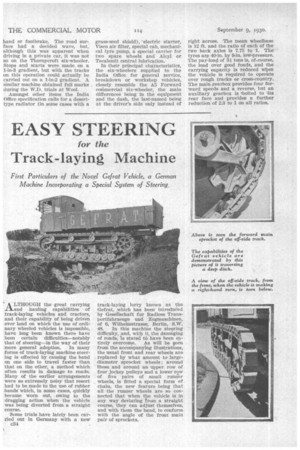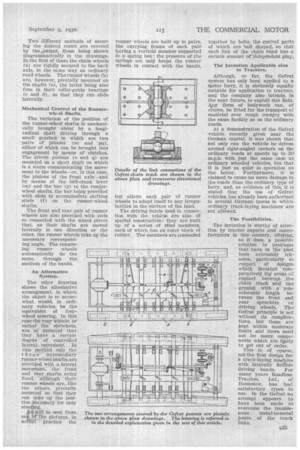EASY STEERING
Page 56

Page 57

If you've noticed an error in this article please click here to report it so we can fix it.
for the
Track-laying Machine
First Particulars of the Nov.el Gefrat Vehicle, a German Machine Incorporating a Special System of Steering, • A LTHOUGH the great carrying .LA.and hauling capabilities of track-laying vehicles and tractors, and their capability of being driven over land on which the use of ordinary wheeled vehicles is impossible, have long been known there have been certain difficulties—notably that of steering—in the way of their more general adoption. In many forms of track-laying machine steering is effected by causing the band on one -side to travel faster than that on the other, a method which often results in damage to roads. Many of the earlier arrangements were so extremely noisy that resort had to be made to the use of rubber bands which, in some cases, quickly became worn out, owing to the dragging action when the vehicle was being diverted from a straight course..
Some trials have lately been carried out in Germany with a new c3.1 track-laying lorry known as the Gefrat, which has been introdueed by Gesellschaft fur Radlose Transportfahrzeuge und Zugmaschinen, of 6, WilhelmStrasse, Berlin,. S.W.
48. In this machine the steering difficulty, and, with it, the damaging of roads, Is stated V-) have been entirely overcome. As will be §een from the acompanying illustrations, the usual front and rear wheels are replaced by what amount to large-diameter sprocket wheels; around these and around an upper row of four jockey pulleys and a lower row of five pairs of small ruteer wheels, is fitted a special form of chain, the new feature being that allthe runner wheels are so connected that when the vehicle is in any way deviating from a straight course, they can adjust themselves, and with them the band, to conform with the angle of the front main pair of sprockets.
Two different methods of securing the desired result are covered by the,patent, these being shown diagrammatically in the drawings. In the first or these the chain wheels (a) are rigidly secured to the back axle, in the same way as ordinary road wheels. The runner wheels (b) are, however, pivotally mounted on the shafts (e), the latter being also free in their roller-guide bearings (c and d), so that they can slide laterally.
Mechanical Control of the Runnerwhs el Shafts.
The variation of the position of the runner-wheel shafts is mechanically brought about by a longitudinal Shaft driving through a small gearboir in which are two pairs of pinions (no and .pq), either of which can be brought into engagement by means of clutches. The driven pinions (o and q) are mounted on a short shaft on which is a Worm commtmicating the move ment to the wheels or, in this case, the pinions of the front axle—and by means of the bell-crank lever (in) and the bar (g) to the runnerwheel shafts, the bar being provided with slots to accommodate shifting studs (1) on the runner-wheel shafts.
The front and rear pair of runner wheels are also provided with rods so connected with the wheel pivots that, as their shafts are moved laterally in one direction or the other, the runner wheels take Up the necessary correspond ing angle. The remain ing runner wheels automatically do the same, through the medium of the bands.
An Alternative System.
The other, drawing shows the alternative arrangement, in which the object is to secure what would, in ordinary _vehicles, be the equivalent of fonrwheel steering. In thie case the rear .evheele, or rather the' *rockets, are so mounted that they have a certain degree" of controlledlateral moven:Lent. In this method only the , three intermediary runner-wheel shafts_ are provided with a lateral movement, the front and rearshafts. being fixed, -although their runner wheel are, like the others, pivotally mounted se that they can take up the position Pecessary for easy steering.
ytff-be seen from on Of:the pictures, hi
ae practice the
runner wheels are built up in pairs, the carrying frame of each pair having a vertical member supported in a spring box; the pressure of the springs not only keeps the runner wheels in contact with the bands,
but allows each pair of runner wheels to adapt itself to any irregularities in the surface of the land.
The driving bands used in connection with the vehicle are also Of speCial construction; they are built -up of a series of steel members, each of which has an outer block of rubber. The members are connected
together by bolts, the central parte' of which are ball shaped, so that each link of the chain hand has a certain amount of independent play.
The Invention Applicable also to Tractors.
Although, so far, the Gefrat system has only been applied to a reator lorry, it is obviously equally suitable for application to tractors, and the company also intends, in the near future, to exploit this field. kay form of bodywork can, of Course, be fitted for the transport of material over rough country with the same facility as on the ordinary roads.
At a demonstration of the Gefrat vehicle recently given near the German capital, it was shown that not only can the vehicle be driven around right-angled corners on the ordinary roads at speeds up to 20 m.p.h. with just the same ease as ordinary wheeled vehicles, but that it is just as quiet in operation as the latter. Furthermore, it is claimed to cause no more damage to the roads than the ordinary type of lorry, and, as evidence of this, it is stated that the use of Qefrat vehicles has already been authorized in several German towns in which ordinary track-laying machines are not allowed.
The Possibilities.
The invention is worthy of attention hy tractor experts and manufacturers in this country, offering, as it does, a possible
solution to prote.ems that have in the past been extrendely irksome, particularly in respect ofwhich involv.ed comparatively bigareas contact between the chain track and the ground, with a -considerable length between the front and rear sprockets or driving ;Wheels, The Gefrat principle is not without its complications, but these arc kept within moderate limits and there need not be many_ components which are iixely to get out of order.
This is, of course, not the first design for a track-laying nuwhine with laterally fleVible driving bands. For many years Roadless Traction, Ltd., cri' Hounslow, has had satisfactory types in use. In the Gefrat no attempt appears to have been made to overcome the troublesome metal-to-metal joints of the track












































































































